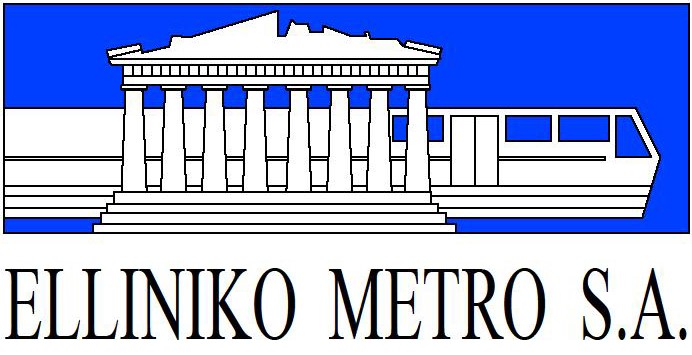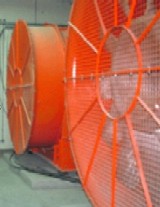An extensive network of E/M systems and special equipment has been installed, aiming at the smooth operation of the Metro system and at the safe and comfortable transportation of the passengers, as well as at securing the proper work conditions for all Metro employees. This network includes the following systems:
Ventilation
The Metro ventilation system is divided into two categories, i.e., the Tunnel / Station passenger areas ventilation system, and the other individual ventilation systems for the Personnel areas and the technical rooms located within each station. The Tunnel / Station passenger areas ventilation system serves two purposes: one purpose is to supply fresh air for ventilation under normal operation conditions, and the second purpose is to extract smoke in case of emergency. Moreover, the various other ventilation systems in the Depots and the Stations, which include more than 200 local fans, ensure the smooth operation of the technical equipment, as well as the proper living conditions for the Metro operation personnel.
Air Conditioning – Heating
Heating / air conditioning units are installed in all Stations and Depots of the Metro, offering an ideal work environment for the personnel as well as for certain areas with sensitive equipment. The Passenger areas within the Stations do not require heating during the winter months, since, on the one hand, the entire Metro network is located at a great depth not susceptible to extreme temperature variations, and, on the other hand, the constant operation of the technical equipment releases additional heat. Moreover, all Metro stations are equipped with spare rooms, which can be fitted in the future with air conditioning units, cooling the air supplied to the passenger areas of each station.
Pumping Stations
In each Metro station and at all low points within the tunnels, double pumps for rainwater have been installed; this rainwater either comes from the surrounding ground, or flows in through the station openings at street level. In addition, each station is equipped with a pair of wastewater pumps.
Fire protection
In all installations of Elliniko Metro, provision has been made for a series of passive and active fire protection measures, in order to minimize the possibility for the outbreak of a fire, as well as to effectively deal with such. The fire protection system and equipment are designed and constructed in close cooperation with the Fire Department. Before inception of revenue operation, all Elliniko Metro installations are inspected by the Fire Department and the relevant Fire Protection Certificate is issued.
Lighting
Thousands of lighting fixtures installed in the stations generate a high luminosity, creating thus a safe and pleasant means of public transport. Battery-operated emergency lighting is provided in all areas, capable to cope with power failures for a period of two hours.
TECHNICAL DETAILS ABOUT AUTOMATIONS
(GENERAL DESCRIPTION OF THE BUILDING AUTOMATION AND CONTROL SYSTEM-BACS)
The purpose of the BACS system is to monitor all tunnel ventilation systems, Station, Heating, Ventilation & Air Condition (HVAC) systems and all E/M systems within stations,shafts, and tunnels of the Metro lines and extensions, which are currently in operation or in the phase of construction or tendering, under normal operation emergency conditions; these systems are the following:
Concerning the Base Project:
- Ventilation System for tunnels and Blast Shafts
Supply Air Fans (SAF)
Under-platform Exhaust Fans (EXF-P)
Intermediate Shafts Exhaust Fans (EXF-I)
Motorized Dampers
Fireman’s Box (FB)
- HVAC System:
Technical Rooms and other areas Exhaust Fans (EXF
Air Handling Unit (AHU)
Water Chillers
Air Conditioning Unit (ACU)
Motorized Dampers (MD)
- Interface with Fire Detection Switchboards
Concerning the Phase A’ Extensions
- Ventilation System for tunnels and Blast Shafts
Blast Shaft Fans (BSF)
Under-platform & Overhead Exhaust Fans (UPE)
Jet Fans (JF) in Tunnels
Roller Shutter Doors (RSD)
Motorized Dampers (MD)
Fireman’s Box (FB)
- HVAC System:
Exhaust Fans (EXF)
Motorized Dampers (MD)
Cooling machines with their associated pumps and installations
Heat Pumps (HP)
Fan Coil Units (FCU)
- E/M System:
Uninterrupted Power Supply (UPS)
Normal and Emergency Lighting
Pumping and drainage systems
Hydrants, deluge valves and pipes (DEV)
Lifts
Escalators
- Interface with Fire Detection Switchboards
- Interface with the Intrusion Detection System
The existing central System already installed in Syntagma Operation Control Center controls all Tunnel Ventilation and HVAC systems of the Base Project and the first phase of the Metro extensions, by means of two independent and parallel systems which have been provided by independent suppliers (SIEMENS and HONEYWELL).
Moreover, each station is fitted with individual controls for the fans and the other equipment; these controls are located on the local switchboards (incorporating Programmable Logical Controllers – PLC), on the Fireman Boxes (FB) and in the Station Mater Rooms (SMR).
From the FBs located in the stations and tunnels, pre-determined fire scenarios can be activated locally at the station and at the two adjacent platforms, while individual commands to the relevant items of equipment can be issued.
With regard to the Base Project, the pre-determined scenarios have already been programmed into the PLCs that are incorporated in the SB3.1 switchboards of the local SAF fans. Moreover, only a few selected alarms appear in the Station Master Room, while only certain selected fans can be controlled (stopping the UPE and SAF fans, starting of the SAFs in reverse mode). The Power Remote Control System (PRCS), a separate system installed in the OCC, monitors and partially controls the E/M equipment of the Stations (e.g., pumps, escalators, etc.).
With regard to the Phase A extensions of the Metro, the pre-determined scenarios have already been programmed into the PLCs that are incorporated in the local switchboards for the UPE/OTE fans. As far as the first phase of the Metro extensions is concerned, all tunnel ventilation and station HVAC systems, as well as the E/M equipment of the station (e.g., lifts, escalators, fire-fighting hydrants and pumps) can be monitored and controlled from the local Building Management System (BMS) located within the SMR, a system which is also interfaced with the central BMS system at the OCC.



